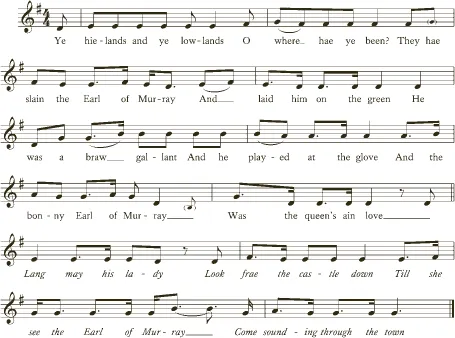![]()
HOMICIDE
There is both more and less to murder than deliberately killing another person. The intention may have been to kill someone else, but the killing is still murder. So is killing when the intention is not to kill but to do serious harm. Curiously, the modern European Convention on Human Rights authorizes killing ‘when absolutely necessary . . . in order to effect a lawful arrest’ – two things which, even in the ballad tradition, seem irreconcilable. Beyond these issues lie such questions as provocation – was the killer goaded beyond what a reasonable person can be expected to endure? – and the mental state which is today classed as diminished responsibility. Then there is killing in self-defence. There is little that is simple about homicide.
Many of these problems turn up in the ballad narratives. The young trooper McCaffery went to the gallows for shooting an officer he had no intention of harming. The Earl of Huntly when he killed the Earl of Murray held a warrant for his arrest. Lord Barnard, not unreasonably, thought Gil Norice was his wife’s lover, not her son. Whether the drowning of the outlandish knight, an admitted serial killer, was legitimate self-defence when the maiden could simply have ridden off is probably of more interest to lawyers than to singers.
THE BONNY EARL OF MURRAY
Ye hielands and ye lowlands
O where hae ye been?
They hae slain the Earl of Murray
And laid him on the green
He was a braw gallant
And he played at the glove
And the bonny Earl of Murray
Was the queen’s ain love
Lang may his lady
Look frae the castle down
Till she see the Earl of Murray
Come sounding through the town
Now woe be tae ye Huntly
And wherefore did ye sae?
I bade ye bring him wi’ ye
But forbade ye him to slay
He was a braw gallant
And he rid at the ring
And the bonny Earl of Murray
He might have been a king
Lang may his lady
Look frae the castle down
Till she see the Earl of Murray
Come sounding through the town.
IN FEBRUARY 1592, the Earl of Huntly secured the king’s commission to arrest his enemy the Earl of Murray and bring him to trial for abetting the Earl of Bothwell’s treasonable activities (in which Huntly himself had been involved). Murray, a Stewart and a famously handsome man, who had obtained the earldom by marrying the Murray heiress, was at his mother’s home at Donibristle with almost no retinue. He tried to fight Huntly off, but the house was set on fire and Murray was hunted down as he tried to escape. His body was left unburied in Leith (hence ‘laid him on the green’). His friends attempted to get Huntly punished, but the king would not act.
The suggestion in the ballad that Murray ‘was the queen’s love’ probably derives from the rumour that not long before his death the queen had been heard speaking fulsomely of him.
Of the known tunes, the earliest is found in Thomson’s Orpheus Caledonius (1733), but perhaps the handsomest, used here, was recovered in north America from the singing of an unnamed Scot who in 1906 had learned it from one of the Murray family. Bronson, acknowledging its modern currency, considers it to have ‘a mournful beauty’ but to be ‘not very folklike, or at any rate balladlike’. Not everyone will agree.
CHILD #181 ROUD #334
GIL NORICE
Gil Norice is tae the greenwood gane
Awa he’s with the wind
His horse is siller-shod afore
Wi’ shining gowd behind
He said unto his wee boy John
‘I see what ye dinna see
I see the first woman that e’er I loved
Or ever lovèd me.’
‘Here is a glove, a glove’ he said
‘Lined with the silver-gray
Tell her to come to the merry greenwood
To speak wi’ Gil Norey.’
‘Here is a ring, a ring’ he said
‘It’s a’ gold but the stane
Tell her to come to the merry greenwood
And ask the leave o’ nane.’
‘And tak tae her this sark o’ silk
Her ain hand sewed the sleeve
Bid her come tae the gay greenwood
And ask not Barnard’s leave.’
‘I daurna gang tae Lord Barnard’s castle
I daurna for my life
I daurna gang tae Lord Barnard’s castle
Tae twine him o’ his wife.’
‘Do I nae pay ye gowd,’ he said
‘Do I nae pay you fee?
How dare you stand my bidding,’ he said
‘When I bid ye tae flee?’
When he came to Lord Barnard’s castle
He tirlèd at the ri...


